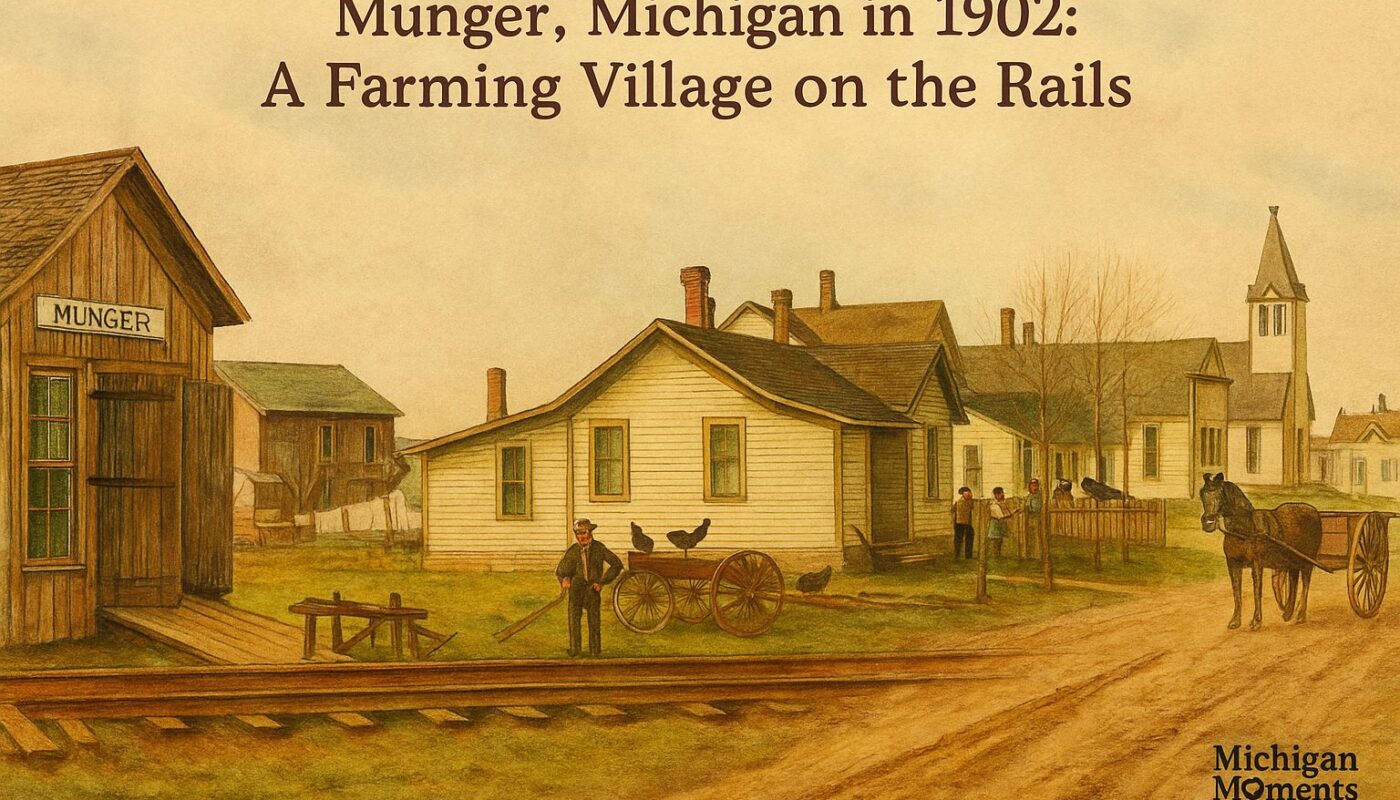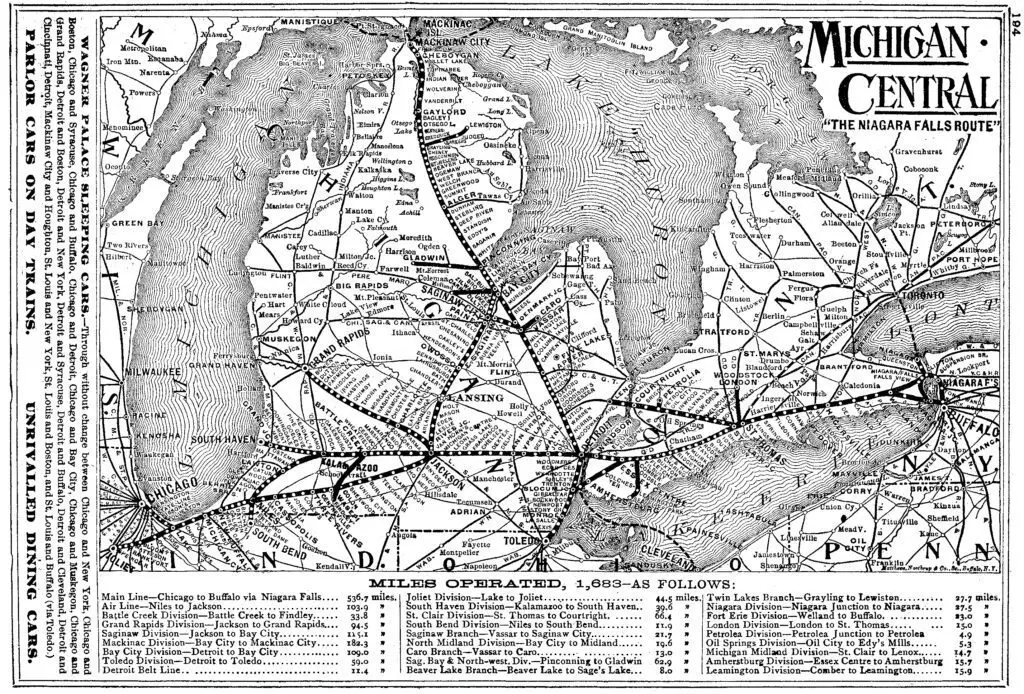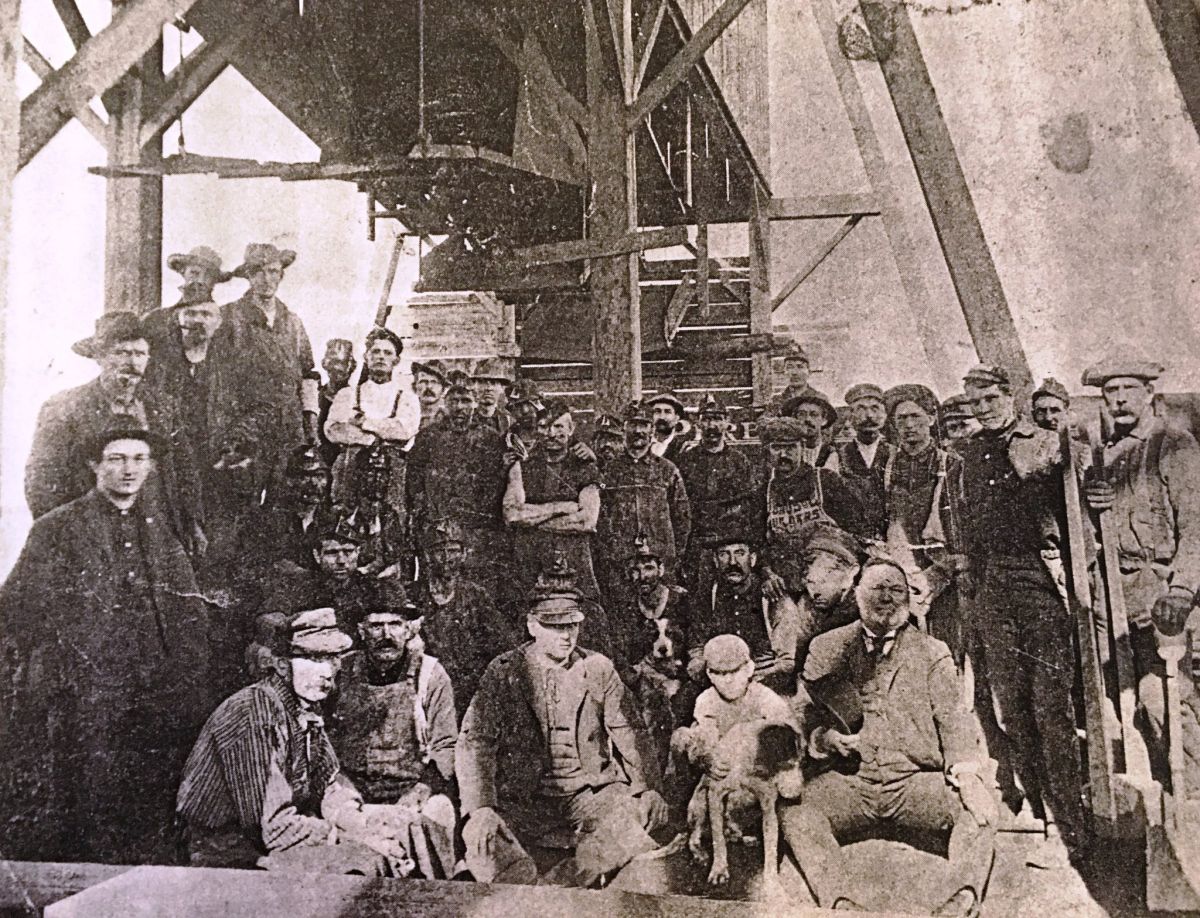In the southeast corner of Bay County lies Munger, Michigan—a rural village shaped by agriculture, faith, and the railroad. While it never incorporated, Munger became the focal point of Merritt Township by the turn of the 20th century. This is the history of Munger Michigan, a place where trains brought mail, churches shaped lives, and fields yielded Michigan’s most important crops.
Video – Blacksmith to Depot: Life in Munger, Michigan 1910–1920
Build a Railroad and They Will Come
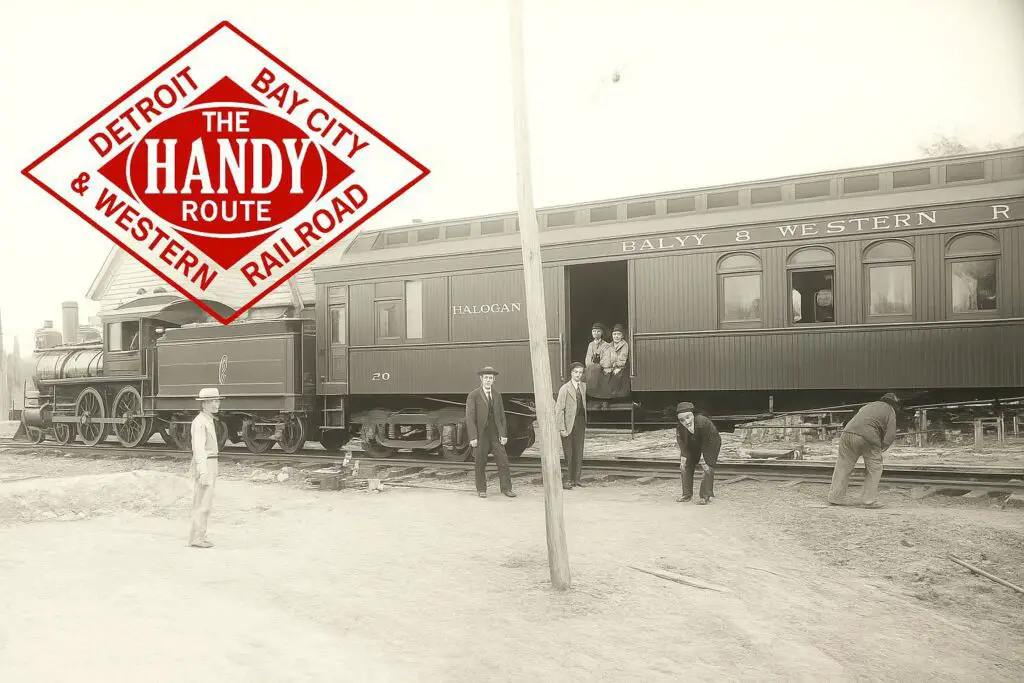
The area that became Munger was long forest and swamp before the railroad. Merritt Township (Bay County) was carved out of neighboring Portsmouth Township in 1871, and soon a rail line was built through it. The Detroit & Bay City Railroad reached Bay City in 1873, and passed through Merritt Township. A station – often called Munger station – was established about 12 miles southeast of Bay City on this line.
Very soon after construction, the Detroit & Bay City was sold or leased to Michigan Central, and the Bay City Division (through Munger) continued as a Michigan Central branch. A post office was opened at Munger on June 6, 1876, marking the community’s formal founding. (Local tradition holds the village was named for Curtis and Algernon Munger, Bay City merchants who owned surrounding farmland.)
Early Beginnings Along the Tracks
By the late 1800s, “the prosperous little farm community at Munger station” had become the rural trading center for Merritt Township. Early settlers included English immigrants (like James S. Ward, who arrived in 1860 and took up a 40-acre farm in 1862) and German and Irish pioneers. For example, Rev. Thomas Histed moved into Merritt Township by the 1850s and helped clear land; later he and other families welcomed itinerant pastors and preachers. Agricultural colonists gradually transformed the old swamps into productive farms.
By the 1880s only a few farms existed, but by 1900 there were over 200 farms in Merritt Township. The village of Munger (located in the southeastern part of Merritt) grew up around the depot and several street-front businesses and homes, serving area farmers.
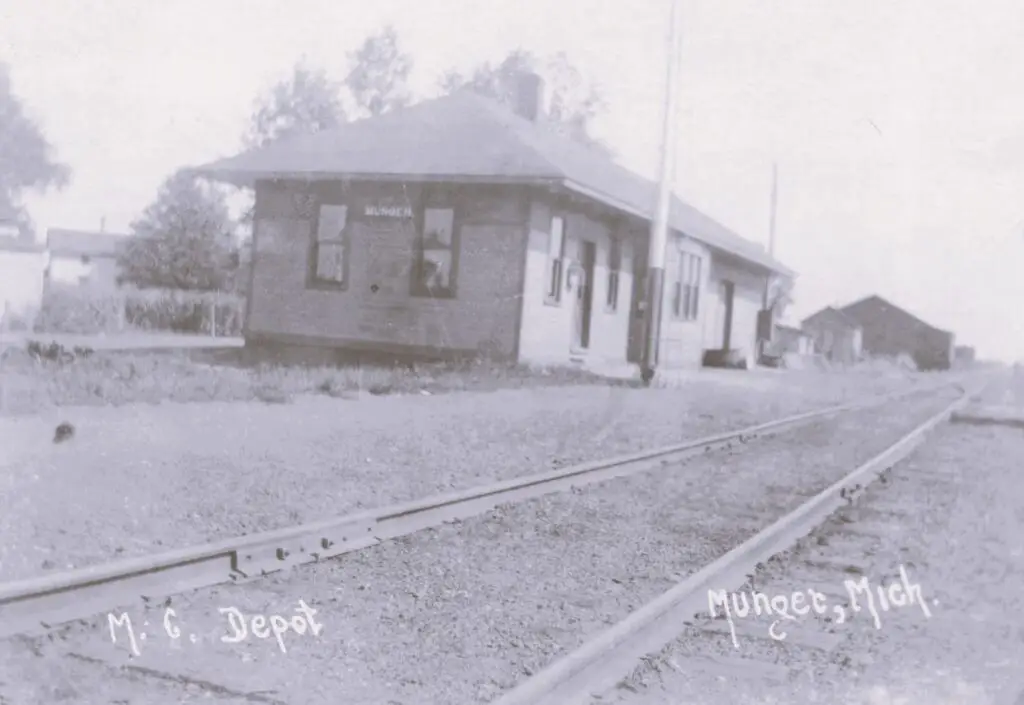
Agricultural Boom and Local Economy
Munger’s economy was overwhelmingly agricultural. Rich Black “muck” soils around Munger produced grains, hay, vegetables and especially sugar beets and potatoes. In the 1890s–1900s the opening of beet-sugar and chicory factories in Bay City greatly increased demand for local crops. A contemporary account notes that with those factories “farm property has advanced in value” and Merritt Township’s farmers grew “some of the banner crops in the county”. The population of Merritt Township grew from about 1,217 in 1894 to 1,562 by 1900, reflecting this boom.
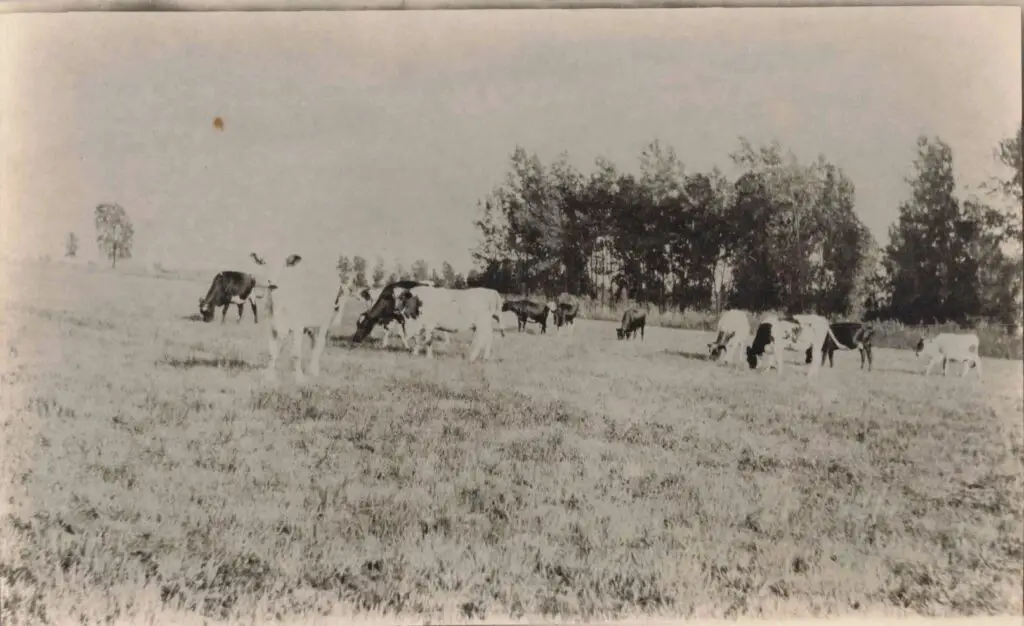
The area’s farmers also sold other products. Cattle and dairy, lumber from remaining woodlots, and produce all went through Munger’s markets. By 1900 Munger had a mill, a creamery, a blacksmith, and several general stores serving the community. A.M. Ward – son of pioneer James S. Ward – by 1900 owned about 200 acres of “finely cultivated” farm just east of Munger. He and other local landowners helped the village prosper through the turn of the century. (In 1900 W.J. Ward’s barn was struck by lightning and lost, but by 1902 he had built an even larger barn – one of the biggest in the township.)
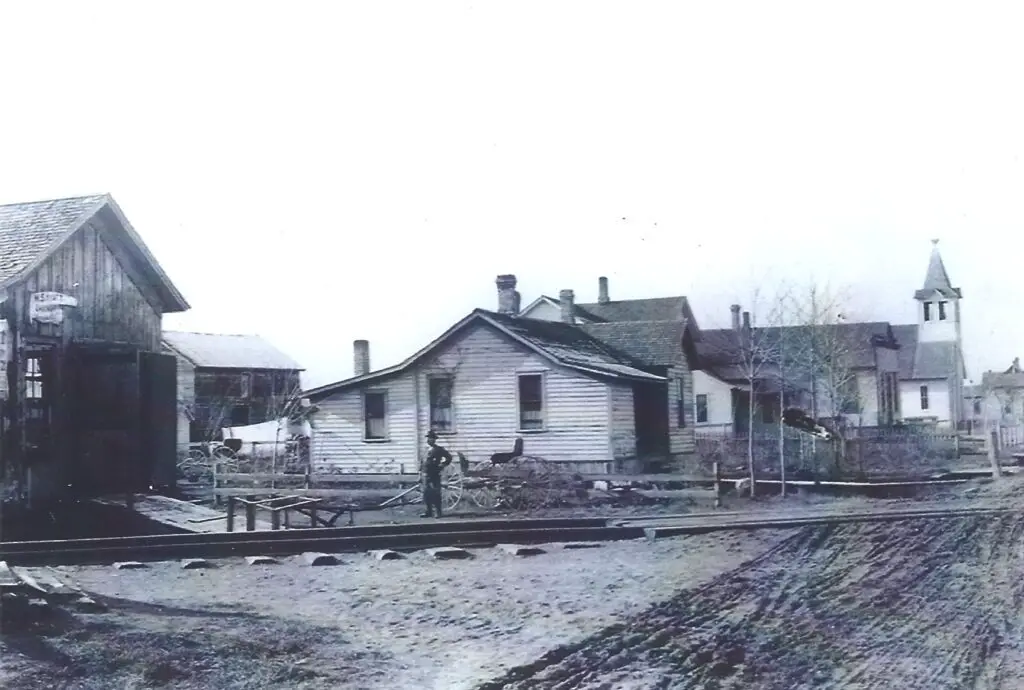
In 1904 the discovery of coal opened a new chapter. The sinking of the “What-Cheer” coal mine marked “a new era for Merritt” – a fine vein was found and neighboring farms were quickly leased for mining. Although coal mining brought some jobs and hopes of prosperity, most of Munger’s farmers continued concentrating on crops. By 1910 the railroad and local roads were shipping sugar-beets, grains and livestock east toward Bay City, while farm families remained the backbone of the community.
Railroad and Infrastructure
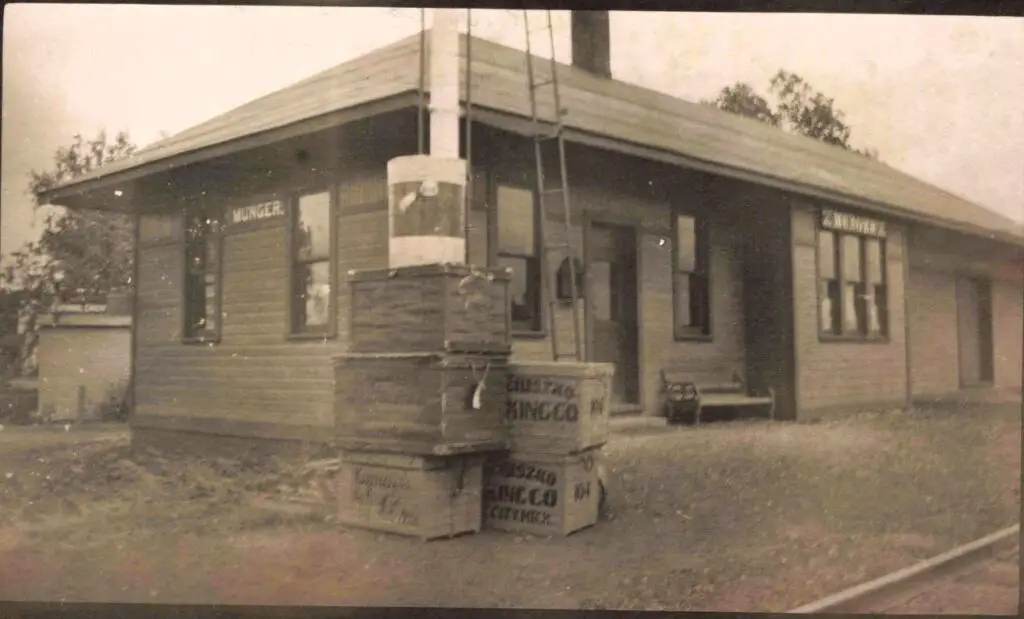
Transportation shaped Munger’s history. The Michigan Central Railroad depot (seen above) was built in the late 1870s and remained Munger’s lifeline. Passenger and freight trains connected Munger to Bay City and beyond. (A 1919 photograph shows the depot building; records note Michigan Central had a station agent in Munger as late as 1917.) The depot sat alongside what is now Munger Road (M-138), which became the main street of the village. Early roads were little more than wagon tracks through the woods, but by the 1890s Munger was linked by plank roads and county roads to neighboring towns. The presence of the railroad meant Munger could ship out produce and import goods – a crucial advantage for the farming community.
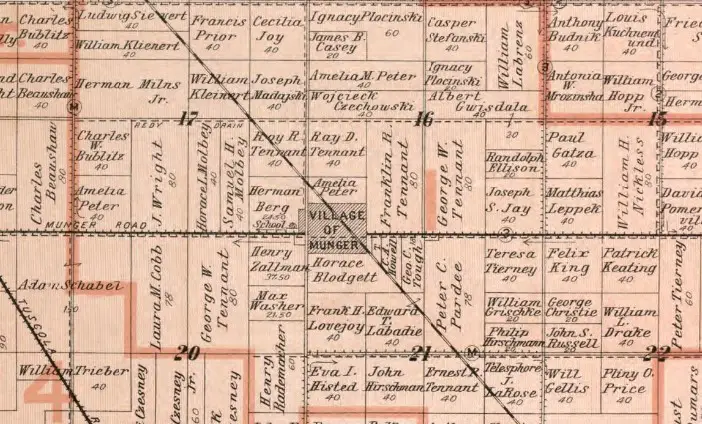
Other infrastructure grew with the town. Munger never incorporated as a village, but it had a town hall in Merritt Township that served as a civic center. In fact, before there was a Catholic church, early Masses and community meetings were held in Merritt Township’s town hall building. By the early 1900s Munger had multiple schools (including district schools nearby) and at least one general-store/post office – common features of Michigan farm villages of the era.
Churches and Education
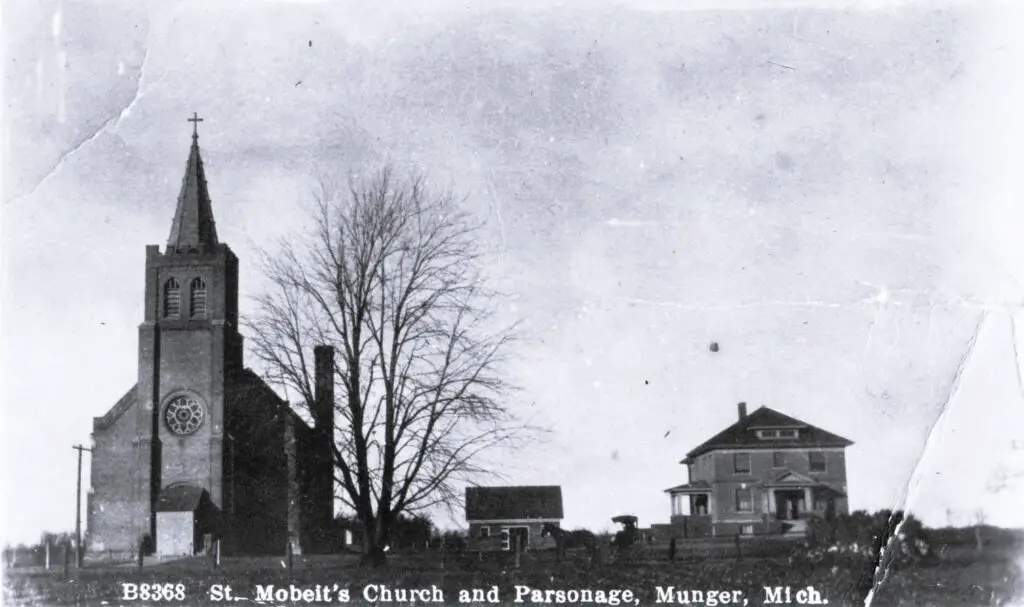
Like many rural Michigan communities, Munger’s social life revolved around churches and schools. By 1900 “each of the leading denominations” had established a house of worship in Merritt Township, and Munger (as the township center) hosted several congregations. The most prominent was St. Norbert’s Catholic Church, founded in the 1900s. Catholic families around Munger (often of Irish or German descent) first held Mass in homes and in 1902 organized a mission parish under Norbertine priests from Essexville.
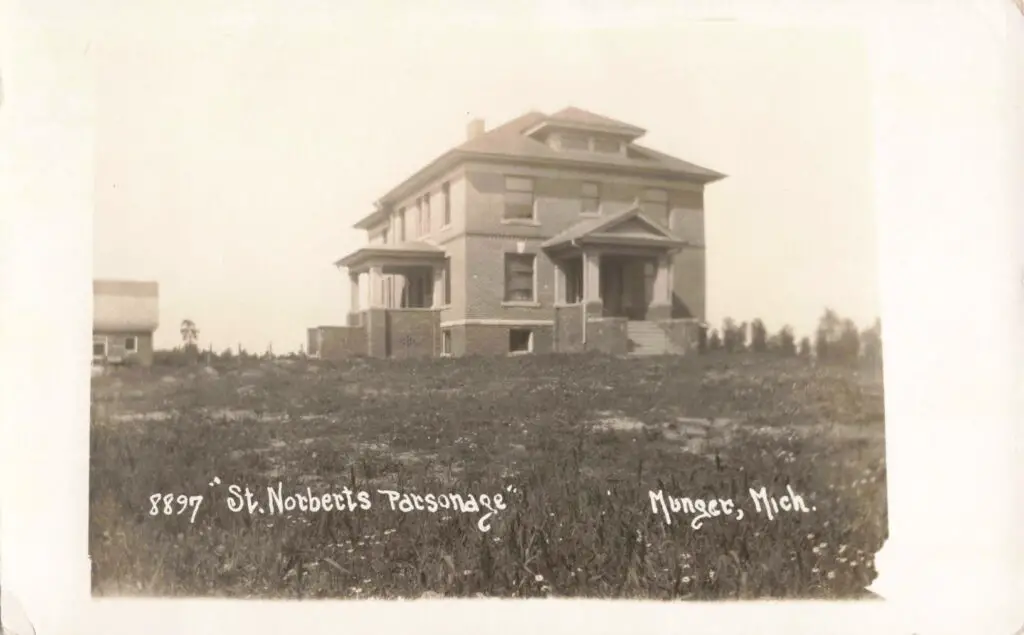
The first St. Norbert church and parsonage were built in 1906–1907, with the cornerstone laid in 1906 and the church dedicated July 17, 1907. In 1910 Munger became a full parish (named St. Norbert’s) under the Diocese of Grand Rapids, with Father James Golden as its first resident pastor; the original rectory was built that same years. (The photo of St. Norbert’s at Munger shows the 1907 church with its parsonage.)
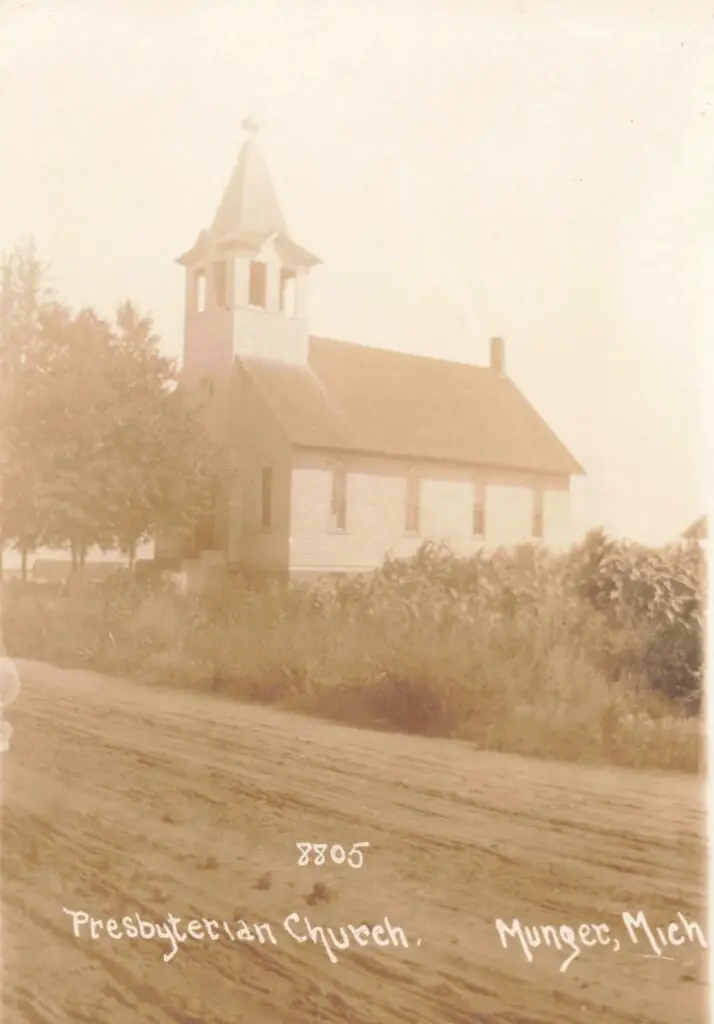
Presbyterians were another key group. In the late 1800s a small Presbyterian congregation served area settlers. Genealogical records show local families like the Clarks and Hortons “attend and take an active interest in the Presbyterian Church at Munger”. By 1900 Munger’s Presbyterian Church had its own building (a 1902 photo caption even mentions “City Hall” alongside it) and local leaders like Henry Horton served as trustees. The Horton family’s bio notes that all their children “belong to the Presbyterian Church at Munger” with the father as trustee.
Lutherans and other Protestants also organized. (Today’s Trinity–St. James Lutheran Church traces its roots to early 20th-century German Lutheran settlers in the Munger area.) Each congregation ran a Sunday School and social events that knit together the sparsely settled community.
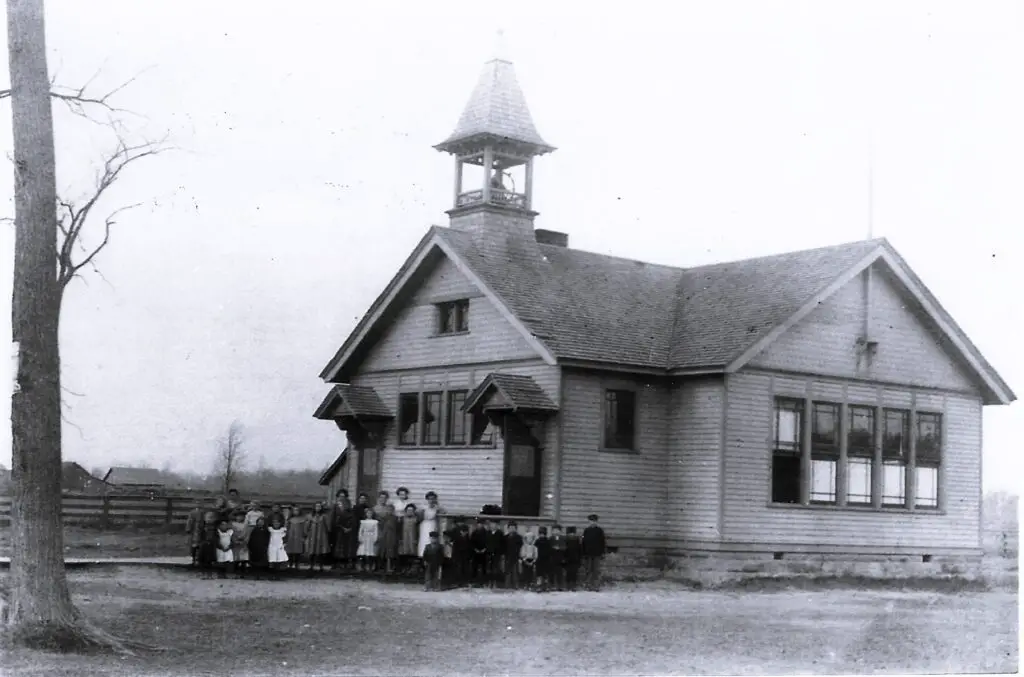
By 1905 one observer noted that Merritt Township’s school facilities were “excellent” and every major denomination was represented by its own church and congregation. Indeed, local one-room schoolhouses – including the Munger school district – educated children until high school became available in Bay City later on.
Notable Residents In the History of Munger Michigan
Early Munger families tended to be large, church-going, and community-minded. The Ward family was prominent: patriarch James S. Ward (born 1818 in England) moved here by 1860, and in 1862 “took up title” to farmland in the township. He lived in Bay City but died in Munger in 1901. His son William J. Ward (b.1858) grew up on the farm and by the turn of the century owned a 200-acre estate of grain, hay and livestock. W.J. Ward was a leading local citizen and school treasurer, noted for rebuilding a grand barn after an 1900 fire.
Another founding figure was Horace D. Blodgett, a longtime postmaster at Munger and one of Merritt’s first settlers. He, like others, helped organize the village’s early businesses. The Bland and Tennant families were also influential (several Tennant men and Horton women married into Munger families, as reflected in local biographies). Politically, Merritt Township remained rural; its voters elected local supervisors and justices, not big-city bosses.
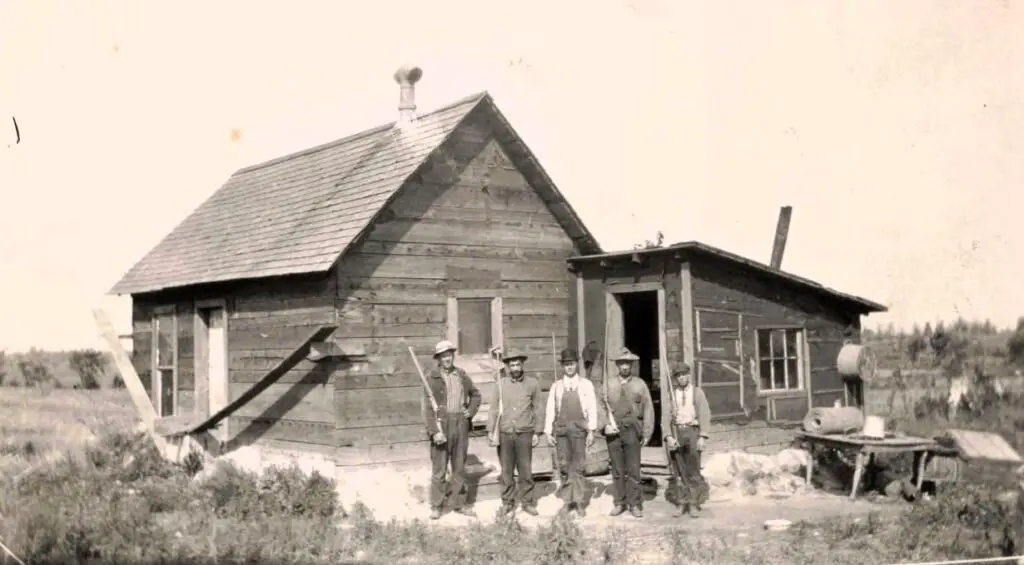
Life in Munger at the turn of the century was quiet and connected to the land. Neighbors gathered for church socials, barn-raisings, and school programs. A photograph from ca. 1900 shows a rural home and farm typical of the era. Local crops were loaded onto rail cars each autumn, and the Munger depot was the community’s main link to the outside world. In winter, the railroad brought mail and groceries. Community events (often held in churches or in the town hall) marked holidays and elections. By the 1910s the population remained modest – likely only a few dozen in the village itself – but Munger’s identity as an agricultural hub was well established.
A Lasting Legacy
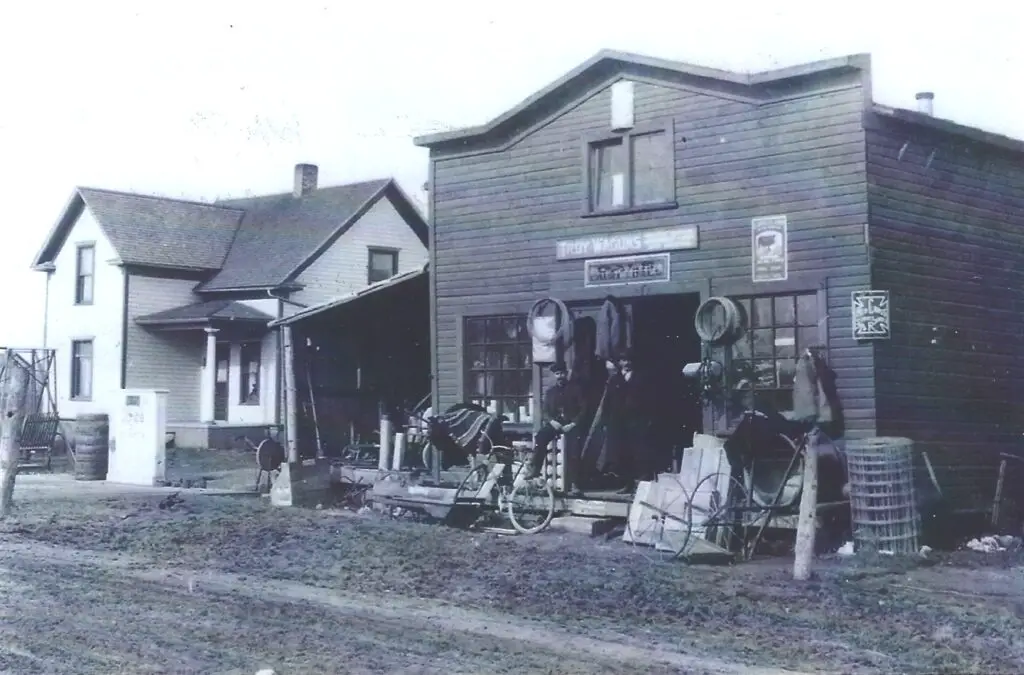
In summary, Munger grew up in the late 19th century as a classic Michigan rural railway village. Founded along the Detroit & Bay City line in the 1870s, it became the trading post for Merritt Township’s farms. Farming (especially sugar beets and livestock) fueled its economy, and coal mining promises briefly glimmered after 1904. Its citizens built churches (Catholic, Presbyterian and others) and schools to serve their families. Though Munger never grew into a town, its history through the 1910s is one of pioneer farming, community institutions, and the railroad – reflecting the broader story of Michigan’s Thumb region in that era.
Sources
Historical county accounts and local records
Michigan state and railroad histories
These include The History of Bay County (1905), local parish histories, and Michigan railroad archives.

